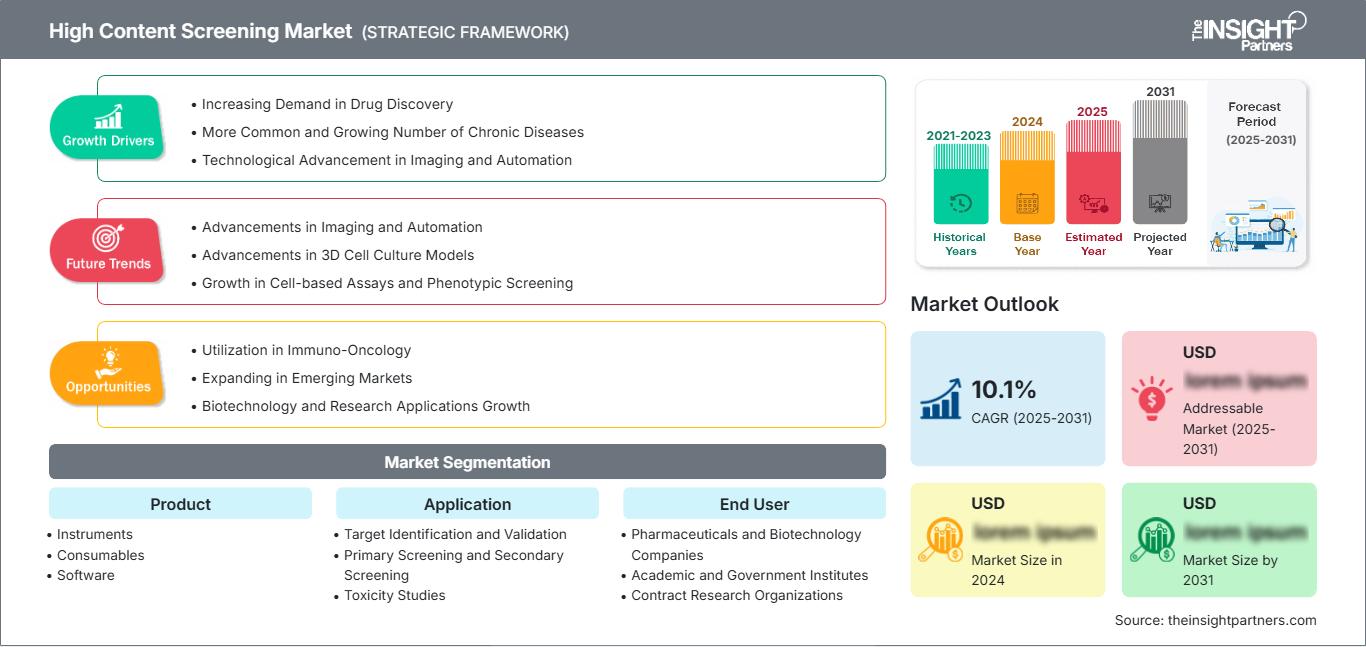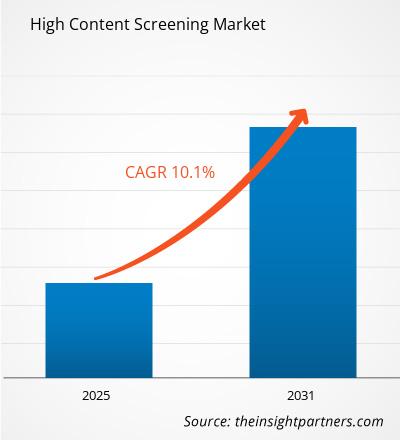Si prevede che il mercato dello screening ad alto contenuto raggiungerà i 2,93 miliardi di dollari entro il 2031. Si prevede che il mercato registrerà un CAGR del 6,6% nel periodo 2025-2031.
Il mercato dello screening ad alto contenuto è suddiviso per prodotto in strumenti, materiali di consumo, software, servizi e accessori. È ulteriormente suddiviso per applicazione, ovvero identificazione e convalida del target, screening primario e secondario, studi di tossicità, composti e altro, e per utenti finali, tra cui aziende farmaceutiche e biotecnologiche, istituti accademici e governativi e organizzazioni di ricerca a contratto (CRO). Le previsioni fino al 2031 offrono preziose informazioni su come la crescita del mercato dello screening ad alto contenuto influisca sulla produttività e sulla soddisfazione del cliente. L'analisi globale è suddivisa a livello regionale e per i principali paesi. La valutazione del mercato è presentata in dollari USA per l'analisi segmentale di cui sopra.
Scopo del rapporto
Il rapporto High Content Screening Market di The Insight Partners mira a descrivere il panorama attuale e la crescita futura, i principali fattori trainanti, le sfide e le opportunità. Ciò fornirà spunti a vari stakeholder aziendali, come:
- Fornitori/Produttori di tecnologia: per comprendere le dinamiche di mercato in evoluzione e conoscere le potenziali opportunità di crescita, consentendo loro di prendere decisioni strategiche informate.
- Investitori: per condurre un'analisi completa delle tendenze in merito al tasso di crescita del mercato, alle proiezioni finanziarie di mercato e alle opportunità esistenti lungo la catena del valore.
- Enti di regolamentazione: per regolamentare le politiche e le attività di controllo sul mercato con l'obiettivo di ridurre al minimo gli abusi, preservare la fiducia degli investitori e sostenere l'integrità e la stabilità del mercato.
Prodotto di segmentazione del mercato dello screening ad alto contenuto
- Strumenti
- Materiali di consumo
- Software
- Servizi
- Accessori
Applicazione
- Identificazione e convalida del target
- Screening primario e screening secondario
- Studi di tossicità
- Composti
Utente finale
- Aziende farmaceutiche e biotecnologiche
- Istituti accademici e governativi
- Organizzazioni di ricerca a contratto
Geografia
- Nord America
- Europa
- Asia-Pacifico
- America meridionale e centrale
- Medio Oriente e Africa
Potrai personalizzare gratuitamente qualsiasi rapporto, comprese parti di questo rapporto, o analisi a livello di paese, pacchetto dati Excel, oltre a usufruire di grandi offerte e sconti per start-up e università
Mercato dello screening ad alto contenuto: Approfondimenti strategici

-
Ottieni le principali tendenze chiave del mercato di questo rapporto.Questo campione GRATUITO includerà l'analisi dei dati, che vanno dalle tendenze di mercato alle stime e alle previsioni.
Fattori di crescita del mercato dello screening ad alto contenuto
- Crescente domanda nella scoperta di farmaci: lo screening ad alto contenuto (HCS) è una tecnologia indispensabile per la ricerca e lo sviluppo di farmaci. In un settore farmaceutico sempre più globalizzato, alla ricerca di metodi più efficienti per lo screening di nuovi farmaci candidati, i sistemi HCS vengono sempre più utilizzati per analizzare migliaia di composti e accertarne gli effetti sulle cellule.
- Numero di malattie croniche più comune e in crescita: il numero di malattie croniche (cancro, diabete, malattie neurodegenerative, ecc.) è in aumento, il che rende ulteriormente necessario l'uso di tecnologie di screening per lo sviluppo di farmaci e la medicina di precisione. Ciò alimenta lo screening ad alto contenuto negli studi biomedici e nella pratica clinica.
- Progressi tecnologici nell'imaging e nell'automazione: si sono registrati progressi significativi nelle tecnologie di imaging, tra cui la microscopia automatizzata, l'imaging 3D e l'analisi delle immagini basata sull'intelligenza artificiale. Queste tecnologie stanno facendo la differenza nel processo HCS, consentendo una maggiore produttività, una migliore accuratezza e una maggiore risoluzione delle risposte cellulari. Tali miglioramenti stanno guidando l'utilizzo dell'HCS in tutti i tipi di ricerca e applicazioni cliniche grazie alla capacità di analizzare grandi librerie di composti a velocità più elevate e con maggiore precisione.
Tendenze future del mercato dello screening ad alto contenuto
- Progressi nell'imaging e nell'automazione: l'automazione nell'imaging automatizzato, nei lettori di micropiastre e nell'analisi dei dati ha migliorato la precisione e la produttività delle soluzioni di screening ad alto contenuto. I sistemi HCS automatizzati offrono coerenza ed efficienza nel rilevamento dei composti attivi, il che guida il mercato.
- Progressi nei modelli di colture cellulari 3D: esiste una tendenza verso l'utilizzo di sistemi di colture cellulari 3D nell'HCS. Questi sistemi consentono di testare i farmaci in un ambiente più fisiologicamente rilevante rispetto alle tradizionali colture 2D. Queste colture rappresentano meglio il complesso tessuto umano e ciò si riflette nei risultati dello screening dei farmaci. Questa crescente domanda sta creando un enorme mercato per piattaforme HCS avanzate a supporto dei sistemi di colture cellulari 3D ed è un motore per la crescita del mercato.
- Crescita dei test cellulari e dello screening fenotipico: si registra una crescente preferenza per i test cellulari rispetto ai tradizionali test biochimici, poiché forniscono informazioni biologiche più rilevanti. Lo screening fenotipico, in particolare, sta guadagnando popolarità grazie alla sua capacità di identificare gli effetti dei composti sui fenotipi cellulari senza preconcetti sui bersagli molecolari. Questa tendenza sta aumentando l'utilità dell'HCS nell'identificazione di nuovi farmaci candidati e nel miglioramento dei modelli di malattia.
Opportunità di mercato per lo screening ad alto contenuto di cellule tumorali
- Utilizzo in immuno-oncologia: lo screening ad alto contenuto di cellule tumorali sta guadagnando popolarità in immuno-oncologia per individuare nuove immunoterapie contro il cancro. Questo nuovo campo di ricerca potrebbe offrire una piattaforma importante per le tecnologie HCS per lo screening di farmaci immunomodulatori che potrebbero migliorare la cura del cancro.
- Espansione nei mercati emergenti: con la crescente domanda globale di medicina di precisione, i mercati emergenti offrono enormi opportunità di crescita per l'espansione delle tecnologie di screening ad alto contenuto. Con la crescita delle infrastrutture sanitarie e dei centri di ricerca in queste regioni, è probabile che l'adozione acceleri.
- Crescita delle applicazioni in biotecnologia e ricerca: l'HCS sta rapidamente crescendo nei campi della ricerca accademica e biotecnologica, in particolare per la ricerca sul cancro, la ricerca sulle cellule staminali e gli studi genetici. La capacità dei sistemi HCS di analizzare fenomeni biologici complessi e di fornire dati ad alta dimensionalità aiuta a comprendere le risposte cellulari, l'espressione genica e i meccanismi delle malattie, creando così uno spazio per l'HCS in istituti di ricerca, aziende biotecnologiche e organizzazioni di ricerca a contratto che si occupano di ricerca avanzata e innovazione.
Le tendenze regionali e i fattori che influenzano il mercato dello screening ad alto contenuto durante il periodo di previsione sono stati ampiamente spiegati dagli analisti di The Insight Partners. Questa sezione illustra anche i segmenti di mercato e la geografia della gestione delle malattie del ritmo cardiaco in Nord America, Europa, Asia-Pacifico, Medio Oriente e Africa, America meridionale e centrale.
Ambito del rapporto di mercato sullo screening di contenuti ad alto contenuto
| Attributo del rapporto | Dettagli |
|---|---|
| Dimensioni del mercato in 2024 | US$ XX Billion |
| Dimensioni del mercato per 2031 | US$ 2.93 Billion |
| CAGR globale (2025 - 2031) | 6.6% |
| Dati storici | 2021-2023 |
| Periodo di previsione | 2025-2031 |
| Segmenti coperti |
By Prodotto
|
| Regioni e paesi coperti |
Nord America
|
| Leader di mercato e profili aziendali chiave |
|
Densità degli operatori del mercato dello screening di contenuti elevati: comprendere il suo impatto sulle dinamiche aziendali
Il mercato dello screening ad alto contenuto è in rapida crescita, trainato dalla crescente domanda degli utenti finali, dovuta a fattori quali l'evoluzione delle preferenze dei consumatori, i progressi tecnologici e una maggiore consapevolezza dei vantaggi del prodotto. Con l'aumento della domanda, le aziende stanno ampliando la propria offerta, innovando per soddisfare le esigenze dei consumatori e sfruttando le tendenze emergenti, alimentando ulteriormente la crescita del mercato.

- Ottieni il Mercato dello screening ad alto contenuto Panoramica dei principali attori chiave
Punti di forza
- Copertura completa: il rapporto analizza in modo esaustivo prodotti, servizi, tipologie e utenti finali del mercato dello screening ad alto contenuto, fornendo un panorama olistico.
- Analisi degli esperti: il rapporto è redatto sulla base della conoscenza approfondita di esperti e analisti del settore.
- Informazioni aggiornate: il rapporto garantisce la pertinenza aziendale grazie alla copertura di informazioni e tendenze dei dati recenti.
- Opzioni di personalizzazione: questo rapporto può essere personalizzato per soddisfare le esigenze specifiche del cliente e adattarsi in modo appropriato alle strategie aziendali.
Il rapporto di ricerca sul mercato dello screening ad alto contenuto può, pertanto, contribuire a guidare il percorso di decodificazione e comprensione dello scenario del settore e delle prospettive di crescita. Sebbene possano esserci alcune valide preoccupazioni, i vantaggi complessivi di questo rapporto tendono a superare gli svantaggi.
- Analisi storica (2 anni), anno base, previsione (7 anni) con CAGR
- Analisi PEST e SWOT
- Valore/volume delle dimensioni del mercato - Globale, Regionale, Nazionale
- Industria e panorama competitivo
- Set di dati Excel
Report recenti
Testimonianze
Motivo dell'acquisto
- Processo decisionale informato
- Comprensione delle dinamiche di mercato
- Analisi competitiva
- Analisi dei clienti
- Previsioni di mercato
- Mitigazione del rischio
- Pianificazione strategica
- Giustificazione degli investimenti
- Identificazione dei mercati emergenti
- Miglioramento delle strategie di marketing
- Aumento dell'efficienza operativa
- Allineamento alle tendenze normative






















 Ottieni un campione gratuito per - Mercato dello screening ad alto contenuto
Ottieni un campione gratuito per - Mercato dello screening ad alto contenuto